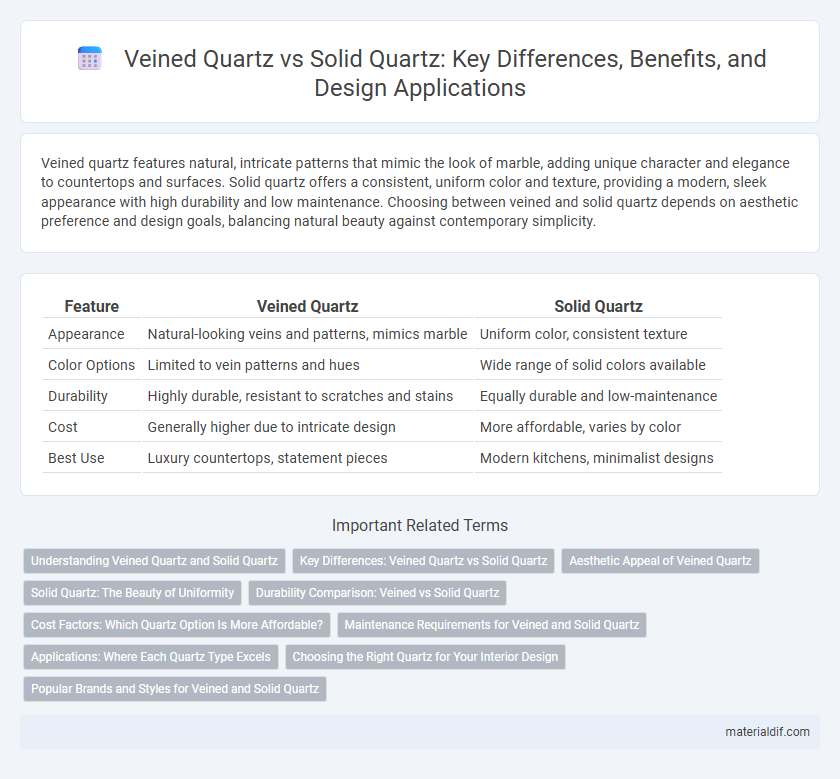Veined quartz features natural, intricate patterns that mimic the look of marble, adding unique character and elegance to countertops and surfaces. Solid quartz offers a consistent, uniform color and texture, providing a modern, sleek appearance with high durability and low maintenance. Choosing between veined and solid quartz depends on aesthetic preference and design goals, balancing natural beauty against contemporary simplicity.
Table of Comparison
| Feature | Veined Quartz | Solid Quartz |
|---|---|---|
| Appearance | Natural-looking veins and patterns, mimics marble | Uniform color, consistent texture |
| Color Options | Limited to vein patterns and hues | Wide range of solid colors available |
| Durability | Highly durable, resistant to scratches and stains | Equally durable and low-maintenance |
| Cost | Generally higher due to intricate design | More affordable, varies by color |
| Best Use | Luxury countertops, statement pieces | Modern kitchens, minimalist designs |
Understanding Veined Quartz and Solid Quartz
Veined quartz features natural or engineered patterns with visible mineral veins that add unique texture and depth, commonly used in countertops and decorative surfaces for its aesthetic appeal. Solid quartz, by contrast, offers a uniform, consistent color and texture, prized for its durability and low maintenance in both residential and commercial applications. Understanding the distinction between veined and solid quartz helps in selecting the appropriate material based on design preferences and functional requirements.
Key Differences: Veined Quartz vs Solid Quartz
Veined quartz features natural or engineered patterns resembling marble veins, adding a unique, decorative texture to countertops and surfaces, while solid quartz offers a consistent, uniform color and appearance. Veined quartz often shows variations in tone and intricate designs, making each slab distinctive, whereas solid quartz provides a sleek, modern look with dependable color uniformity. Both types share durability and low maintenance but cater to different aesthetic preferences for interior design.
Aesthetic Appeal of Veined Quartz
Veined quartz offers a unique aesthetic appeal with its intricate patterns and natural-looking veins that mimic the beauty of marble, creating a sophisticated and luxurious surface. The varied veining provides a dynamic visual interest, making each slab one-of-a-kind and highly desirable for decorative countertops and interior design. Unlike solid quartz, which has a uniform appearance, veined quartz adds depth and texture that elevate the overall ambiance of any space.
Solid Quartz: The Beauty of Uniformity
Solid quartz offers a sleek, uniform appearance with consistent color and texture, making it ideal for modern countertops and sleek architectural designs. Its homogenous composition ensures durability and ease of maintenance, resisting stains and scratches better than veined quartz. This uniformity in solid quartz enhances visual simplicity and compatibility with minimalist interiors.
Durability Comparison: Veined vs Solid Quartz
Veined quartz features natural-like patterns that do not compromise its durability compared to solid quartz, as both are engineered with high-density quartz crystals and resin for strength and resistance to scratches, stains, and heat. Solid quartz typically offers a more uniform surface that may better hide minor wear and tear over time, but veined quartz's durability remains comparable, making it suitable for high-traffic areas such as kitchen countertops. Both types provide exceptional hardness, generally ranking 7 on the Mohs scale, ensuring long-lasting performance under everyday use.
Cost Factors: Which Quartz Option Is More Affordable?
Veined quartz typically costs less than solid quartz due to its composite structure blending natural stone fragments with resin, reducing raw material expenses. Solid quartz is more expensive because it consists of higher concentrations of natural quartz, which requires more intensive processing and truer stone-like properties. Price differences also depend on the rarity of veining patterns and overall slab thickness, with solid quartz slabs generally commanding higher market value.
Maintenance Requirements for Veined and Solid Quartz
Veined quartz requires careful maintenance to preserve the integrity of its intricate patterns, often necessitating non-abrasive cleaners and prompt spill removal to prevent staining. Solid quartz, with its uniform surface, tends to be more forgiving and easier to maintain, allowing for straightforward cleaning and enhanced resistance to discoloration. Both types benefit from routine wiping with mild soap and water, but veined quartz demands extra vigilance to avoid dulling its natural veining effects.
Applications: Where Each Quartz Type Excels
Veined quartz features natural patterns that excel in decorative applications such as countertops, backsplashes, and feature walls, offering unique aesthetics and visual depth. Solid quartz, characterized by uniform color and texture, is ideal for high-traffic and commercial environments due to its consistent appearance and ease of maintenance. Both types are highly durable and non-porous, but the choice depends on whether design emphasis or uniformity is the priority in residential or commercial settings.
Choosing the Right Quartz for Your Interior Design
Veined quartz offers a dynamic, natural stone appearance with intricate patterns that enhance the aesthetics of luxury kitchens and bathrooms, making it ideal for designers seeking unique visual texture. Solid quartz provides a sleek, uniform look with consistent color and minimal variation, perfect for modern, minimalist interiors requiring understated elegance and easy maintenance. Selecting between veined and solid quartz depends on the desired style complexity, color coordination, and the overall theme of the space, ensuring a cohesive and personalized interior design.
Popular Brands and Styles for Veined and Solid Quartz
Veined quartz, favored by brands like Caesarstone and Silestone, features intricate, natural-looking patterns ideal for luxurious countertops and backsplashes, while solid quartz, prominently produced by Cambria and LG Hausys, offers uniform colors and sleek styles perfect for modern, minimalist interiors. Popular veined quartz styles often mimic marble with rich veining variations, whereas solid quartz styles emphasize consistent hues for versatile design applications. Both types cater to high-end residential and commercial projects, with veined quartz attracting those seeking classic elegance and solid quartz appealing to fans of contemporary simplicity.
Veined Quartz vs Solid Quartz Infographic

 materialdif.com
materialdif.com